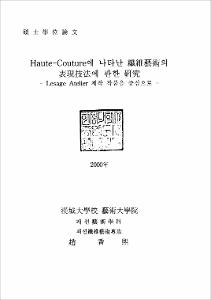Haute-Couture에 나타난 纖維藝術의 表現技法에 관한 硏究
- Abstract
- The purpose of this study is to investigate various expressional techniques of textile are in Haute-couture ultimately to meet diverse demands of modern men and give them some aesthetical pleasure through developments of designs and items qualitatively improved.
In this study, organization and roles of Haute-Couture being Kept open on the basis of creativity and firm technology are examined, and Lesage Atelier among many ateliers, the generator of handicraft technologies that supports Haute-Couture works to create high values added, is concisely introduced.
Also the concept of textile art is defined and various expressional techniques are classified. The 3rd chapter of this study includes the lives and works of Haute-Couture designers who enhanced the quality of costume by using handicraft-like techniques and manifested their personal opinions about fashion style, beauty and life through inspiration and actual works. In the 4th chapter, works of Haute-couture designers made at Lesage Atelier are examined and analyzed by the designers, year of production, expressional techniques, design motifs, dominant colors, parts for applying textile techniques and materials.
To conduct this study, works of 20C Haute-Couture designers made at Lesage Atelier showing handicraft textile techniques have been chosen as the subject, relevant domestic and foreign literature such as technical books, fashion magazines and books related to textile art have been referred and related photos have been presented in the analysis of works.
And the results of this study can be summarized as follows:
First, Haute-Couture designers apply various textile art techniques to their own works to improve quality and heighten values added. Among them, embroidery is the most frequently used including applique, patchwork, fagoting, relief, machine embroidery, coiling, luneville, boulle furniture marquestry, spray, and hand painting techniques, sometimes along with inside-out sequins fixing and tapestry imitating or camaieu and ombre effects.
Second, designer's view of fashion mode and work trends are formalized to be expressed in works through inspiration. This is because they get inspirations from current artistic tendencies, materials of a particular age, nature, personal taste and situations of the times and make them as a fountain of their creativity.
Third, dominant colors primarily depend on the designer's taste and design motif. Sometimes the designer's taste determines the dominant color on the whole and sometimes his character determines main colors in part. At times they extract unique colors from nature or materials of a particular age or create their own colors.
Fourth, application of textile techniques is mainly centered on the upper parts of dress like bodice, bustier, bolero and jacket and the bottom lines of skirt. Sometimes they are applied to the overall cloth and sometimes to pocket, neckline or sleeve. And textile techniques are broadly applied to accessory areas including belt, hat, decoration rose, necklace, shoes, gloves, fan, handkerchief, shawl, parasol, earring, and ring.
Fifth, chief materials include sequin, bugle, bead, rhinestone, precious stone, semi-precious stone, gold and silver plates, gold, silver, ribbon, turtle-shell, plastic, glass piece, soft iron, pearl, china bit, silk-thread cord, chenille, gold and silver thread, embossed gold silk thread, golden cord, passementerie of gold thread, fine silk cord, and guipure cord. As a unique material, bird's feather and wild animal's fur are used, and sometimes silk applique flower leaf.
As we have seen above, richness of expressional techniques and colors and variety of decorative skills and materials intensify the artistry of textile art, reflect designers' sensitivity and thoughts, represent themselves as a background or theme of work, make human body attractive, and create strong outlines of simple surface through organic combinations. Items produced on the basis of these results will not only satisfy diverse demands of modern men but also create high values added with designs qualitatively improved. so the author of this study hopes this study could be a help in the development of design and production of fashion based on textile art techniques of high quality. But further studies are required to conduct a broad range of experiments and to accumulate experiences for developing designs and producing fashion commodities through textile art techniques.
- Issued Date
- 2000
- Type
- Thesis
- Files in This Item:
-
-
Download
 000000066053.pdf
기타 데이터 / 6.06 MB / Adobe PDF
000000066053.pdf
기타 데이터 / 6.06 MB / Adobe PDF
-
Items in Repository are protected by copyright, with all rights reserved, unless otherwise indicated.